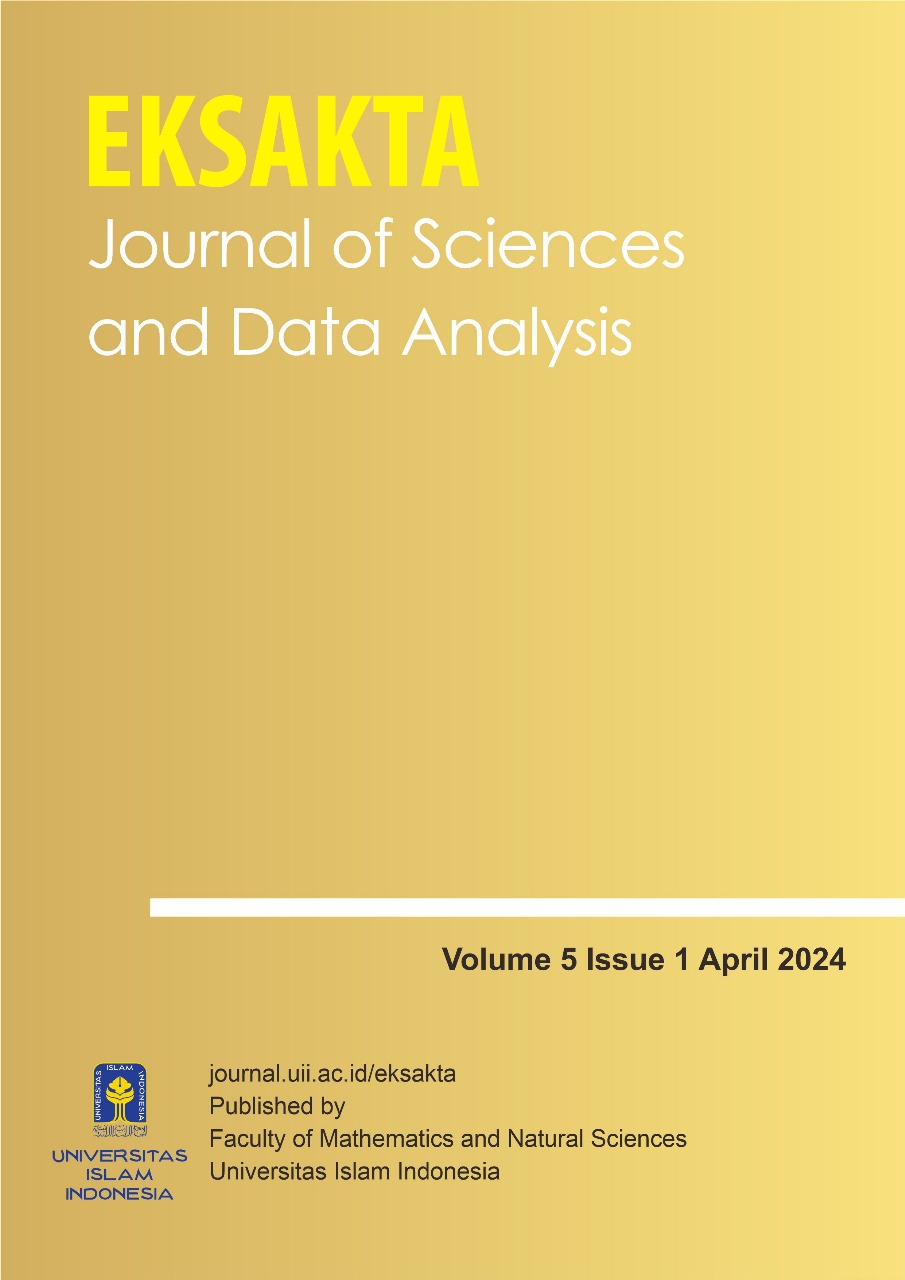Main Article Content
Abstract
Export is a trading activity carried out between countries by bringing or sending goods originating from within the country to foreign countries with the aim of selling or marketing them. Exports as a source of state revenue are needed for the economy because exports can make a major contribution to economic stability and growth. Export values that experience a decrease or increase in the future need to be considered. For this reason, the purpose of this study is to forecast the value of exports in Indonesia for the coming period. Export value data is treated as hierarchical time series data. The top-down method is applied based on historical proportions, so only the total series of export values needs to be modeled. This study implements Autoregressive Integrated Moving Average (ARIMA) to model the total series of export values. The performance of the method is evaluated based on the out-of-sample mean absolute percentage error (MAPE). The results show that the MAPE for out-of-sample is 9.91%. These results indicate that the performance of the method for forecasting export values in Indonesia is highly accurate.
Keywords
Article Details
Authors who publish with this journal agree to the following terms:
- Authors retain copyright and grant the journal right of first publication with the work simultaneously licensed under a Creative Commons Attribution License that allows others to share the work with an acknowledgment of the work's authorship and initial publication in this journal.
- Authors are able to enter into separate, additional contractual arrangements for the non-exclusive distribution of the journal's published version of the work (e.g., post it to an institutional repository or publish it in a book), with an acknowledgment of its initial publication in this journal.
- Authors are permitted and encouraged to post their work online (e.g., in institutional repositories or on their website) prior to and during the submission process, as it can lead to productive exchanges, as well as earlier and greater citation of published work (See The Effect of Open Access).
References
- S. Aryanto, Syaparuddin, and S. Aminah, “Analisis Dampak Nilai Tukar dan Penanaman Modal Asing terhadap Nilai Ekspor Indonesia Periode 1990-2018,” J. Ekon. Aktual, vol. 1, no. 1, pp. 11–22, 2021.
- Pemerintah Republik Indonesia, Undang-Undang Republik Indonesia Nomor 42 Tahun 2009 tentang Perubahan Ketiga Atas Undang-Undang Nomor 8 Tahun 1983 tentang Pajak Pertambahan Nilai Barang dan Jasa dan Pajak Penjualan Atas Barang Mewah. Indonesia, 2009.
- S. Hodijah and G. P. Angelina, “Analisis Pengaruh Ekspor dan Impor Terhadap Pertumbuhan Ekonomi di Indonesia,” J. Manaj. Terap. Dan Keuang., vol. 10, no. 01, pp. 53–62, 2021.
- Wikipedia, “Daftar Negara Menurut Jumlah Ekspor,” 2022. https://id.wikipedia.org/wiki/Daftar_negara_menurut_jumlah_ekspor.
- R. J. Hyndman and G. Athanasopoulos, Forecasting: Principles and Practice Second Edition. Melbourne: OTexts, 2018.
- G. Athanasopoulos, R. A. Ahmed, and R. J. Hyndman, “Hierarchical Forecasts for Australian Domestic Tourism,” Int. J. Forecast., vol. 25, no. 1, pp. 146–166, 2009.
- R. J. Hyndman, R. A. Ahmed, G. Athanasopoulos, and H. L. Shang, “Optimal Combination Forecasts for Hierarchical Time Series,” Comput. Stat. Data Anal., vol. 55, no. 9, pp. 2579–2589, 2011.
- I. G. S. A. Prayoga, S. P. Rahayu, and Suhartono, “Hierarchical Forecasting Method Based on ARIMAX and Recurrent Neural Network for Motorcycle Sales Prediction,” Int. J. Appl. Math. Stat., vol. 53, no. 5, pp. 116–124, 2015.
- L. Lapide, “Top-Down & Bottom-Up forecasting in S&OP,” J. Bus. Forecast. Methods Syst., vol. 25, no. 2, 2006.
- D. C. Montgomery, C. L. Jennings, and M. Kulahci, Time Series Analysis and Forecasting Second Edition. Hoboken, New Jersey: John Wiley & Sons, Inc., 2015.
- H. L. Shang and P. W. F. Smith, “Grouped Time-Series Forecasting With an Application to Regional Infant Mortality Counts,” 2013.
- J. J. M. Moreno, A. P. Pol, A. S. Abad, and B. C. Blasco, “Using the R-MAPE Index as a Resistant Measure of Forecast Accuracy,” Psicothema, vol. 25, no. 4, pp. 500–506, 2013.
References
S. Aryanto, Syaparuddin, and S. Aminah, “Analisis Dampak Nilai Tukar dan Penanaman Modal Asing terhadap Nilai Ekspor Indonesia Periode 1990-2018,” J. Ekon. Aktual, vol. 1, no. 1, pp. 11–22, 2021.
Pemerintah Republik Indonesia, Undang-Undang Republik Indonesia Nomor 42 Tahun 2009 tentang Perubahan Ketiga Atas Undang-Undang Nomor 8 Tahun 1983 tentang Pajak Pertambahan Nilai Barang dan Jasa dan Pajak Penjualan Atas Barang Mewah. Indonesia, 2009.
S. Hodijah and G. P. Angelina, “Analisis Pengaruh Ekspor dan Impor Terhadap Pertumbuhan Ekonomi di Indonesia,” J. Manaj. Terap. Dan Keuang., vol. 10, no. 01, pp. 53–62, 2021.
Wikipedia, “Daftar Negara Menurut Jumlah Ekspor,” 2022. https://id.wikipedia.org/wiki/Daftar_negara_menurut_jumlah_ekspor.
R. J. Hyndman and G. Athanasopoulos, Forecasting: Principles and Practice Second Edition. Melbourne: OTexts, 2018.
G. Athanasopoulos, R. A. Ahmed, and R. J. Hyndman, “Hierarchical Forecasts for Australian Domestic Tourism,” Int. J. Forecast., vol. 25, no. 1, pp. 146–166, 2009.
R. J. Hyndman, R. A. Ahmed, G. Athanasopoulos, and H. L. Shang, “Optimal Combination Forecasts for Hierarchical Time Series,” Comput. Stat. Data Anal., vol. 55, no. 9, pp. 2579–2589, 2011.
I. G. S. A. Prayoga, S. P. Rahayu, and Suhartono, “Hierarchical Forecasting Method Based on ARIMAX and Recurrent Neural Network for Motorcycle Sales Prediction,” Int. J. Appl. Math. Stat., vol. 53, no. 5, pp. 116–124, 2015.
L. Lapide, “Top-Down & Bottom-Up forecasting in S&OP,” J. Bus. Forecast. Methods Syst., vol. 25, no. 2, 2006.
D. C. Montgomery, C. L. Jennings, and M. Kulahci, Time Series Analysis and Forecasting Second Edition. Hoboken, New Jersey: John Wiley & Sons, Inc., 2015.
H. L. Shang and P. W. F. Smith, “Grouped Time-Series Forecasting With an Application to Regional Infant Mortality Counts,” 2013.
J. J. M. Moreno, A. P. Pol, A. S. Abad, and B. C. Blasco, “Using the R-MAPE Index as a Resistant Measure of Forecast Accuracy,” Psicothema, vol. 25, no. 4, pp. 500–506, 2013.




